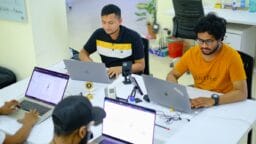The Emergence of Vibe Coding: A Double-Edged Sword for Entrepreneurs
In the rapidly shifting realm of software development, a novel concept referred to as vibe coding is redefining the methodologies by which entrepreneurs construct and expand their ventures.
This artificial intelligence-driven technique enables users to generate code through natural language input, thereby democratizing the process of app and website creation for those without technical expertise.
As Forbes has recently observed, vibe coding empowers small enterprises to expedite product launches while minimizing costs, guaranteeing tangible returns on investment in a climate where nimbleness is paramount.
However, lurking beneath this innovative exterior are significant security vulnerabilities that pose risks to even the most promising startups.
Entrepreneurs are gravitating towards vibe coding tools, captivated by the potential to transform nebulous ideas into operational software without extensive programming knowledge.
Platforms that utilize large language models (LLMs) interpret “vibes”—informal descriptions—to produce code snippets, complete applications, or even comprehensive systems.
This evolution is especially attractive to solo entrepreneurs or small teams devoid of specialized developers, as highlighted in a TechRadar analysis released mere hours ago, which underscores the necessity of prioritizing security in this new era.
Yet, the very speed and accessibility that render vibe coding a transformative force also magnify risks, morphing what appears to be a shortcut into a potential quagmire.
The allure of vibe coding is irrefutable: envision outlining a mobile app designed for personalized fitness coaching, only to have an AI generate the backend code within minutes. Nevertheless, as adoption accelerates, so do the alerts from cybersecurity specialists.
Recent commentary on X, formerly Twitter, amplifies these growing apprehensions, with analysts like Florian Roth forecasting increases in supply chain attacks targeting tools such as NPM and PyPI, which are essential components of many vibe coding workflows.
These platforms, utilized for package management, become conduits for malicious code infiltration when dependencies generated by AI remain unverified.
The Security Conundrum of AI-Generated Code
At the crux of vibe coding’s security challenges is the inscrutable nature of AI-generated code. In contrast to traditional coding, where developers meticulously craft and scrutinize each line, vibe coding depends on black-box algorithms that may introduce subtle defects.
A SC Media webcast summary from August detailed vulnerabilities specific to this approach, such as hallucinated code that appears operational yet conceals backdoors or flawed logic susceptible to exploitation.
Entrepreneurs, often fixated on swift prototyping, may neglect these concerns, culminating in deployments fraught with weaknesses.
Furthermore, the reliability of AI outputs is inherently uncertain. Sonya Moisset, a security advocate at Snyk, elaborated in the same SC Media segment on the necessity for new tools and perspectives in evaluating generated code.
For example, AI may reference outdated or compromised training data, embedding well-known vulnerabilities such as SQL injection or cross-site scripting (XSS) flaws.
This predicament is especially pronounced for entrepreneurs, as indicated in a recent IT Pro report from October, which suggests that those leveraging vibe coding are increasingly exposed to threats in firms lacking robust security teams.
Incidents in the real world illuminate the gravity of these risks. A recent report from WebProNews explored the phenomenon of “vibe hacking,” in which malicious actors exploit AI tools to fabricate harmful code disguised as innocuous prompts.
One instance involved a startup’s e-commerce platform being compromised by an AI-recommended library containing a concealed trojan, resulting in data breaches that impacted thousands of users.
Such occurrences serve to illustrate how entrepreneurs, eager to innovate swiftly, may inadvertently integrate unverified code, thus transforming their advancements into liabilities.
Supply Chain Risks and the Entrepreneur’s Quandary
Supply chain vulnerabilities present yet another critical concern within the Vibe coding framework. As AI tools advocate third-party packages to satisfy prompts, entrepreneurs may unknowingly introduce dependencies that are compromised.
Posts on X from specialists like vxdb caution against insider threats, wherein disgruntled employees or external actors gain access to private repositories, thereby heightening risks in AI-assisted environments.
This aligns with Florian Roth’s projections for Q4 2025, which predict a surge in attacks on tools such as VSCode extensions, extensively employed by Vibe coders.
For startups, the stakes could not be higher. A Sonatype blog published in October posits that maintaining equilibrium between innovation and security is crucial, as vibe coding accelerates development, often at the expense of provenance verification.
Entrepreneurs are faced with the phenomenon of “security debt,” a concept elaborated upon in a DevPro Journal article from last month, where unrelenting vulnerabilities accumulate like financial obligations, risking the viability of a business through breaches or regulatory fines.
Mitigating these risks begins with awareness; however, implementation poses a challenge for resource-constrained founders. Tools such as automated scanners from Snyk or analogous platforms can flag issues in AI-generated code, yet uptake remains insufficient.
As Complex Discovery remarked in July, compliance professionals must adapt governance frameworks to keep pace with AI’s rapid development, ensuring that vibe coding does not outstrip security protocols.
The Dark Evolution: From Vibe Coding to Vibe Hacking
The shift from vibe coding to vibe hacking signifies a more sinister transformation, as elaborated in a TechRadar article from last week. Hackers are now harnessing analogous AI inputs to create exploits, automating assaults that target the very vulnerabilities introduced by vibe coding.
This “dark side,” as termed by WebProNews, features genuine breaches where AI-led campaigns manage 80-90% of operations, per a recent X post from user Jake Lindsay referencing confirmations from Anthropic about exploited code.
Entrepreneurs are confronted with compounded risks in critical industries. While vibe coding is not directly associated with infrastructure like power grids—prohibited under broader safety guidelines—its application in business applications can indirectly impact operations.
OpenAI’s recent alerts, reported by OpenTools AI just yesterday, advocate for sustained human oversight to safeguard code quality and security, cautioning against excessive dependence on AI.
Insiders in the industry on X, like Dr. Khulood Almani, anticipate a decline in AI hype by 2025, shifting towards pragmatic applications amid escalating threats and identity management challenges.
For entrepreneurs, this necessitates the early integration of DevSecOps, as articulated by Alex Xu in a prior X discussion, evolving DevOps to incorporate security measures from conceptualization onward.
Cultivating a Security-First Ethos in Startups
Nurturing a security-centric culture is imperative for entrepreneurs maneuvering through the realm of vibe coding. As Shantanu Kulkarni noted on X last week, secure code constitutes a product decision, rather than mere compliance.
Startups that emphasize threat modeling and code review, as per DevPro Journal, sidestep the pitfalls associated with novel development strategies. This encompasses minor initiatives like routine audits and team education regarding AI-related risks.
Numerous pragmatic strategies exist. Security Boulevard suggests pursuing vibe coding “with a conscience,” wherein AI is harmonized with cybersecurity protocols such as multi-factor authentication for code repositories and carefully engineered AI prompts to avert vulnerable outcomes.
Entrepreneurs should leverage open-source tools for vulnerability assessments, ensuring that the generated code undergoes rigorous scrutiny prior to deployment.
Case studies from resilient startups present valuable templates. An anonymous founder, sharing insights on X via Itunuoluwa Olorunfemi, emphasized the importance of incorporating security from the ideation stage to launch, resulting in cost savings through breach prevention.
Conversely, those disregarding precautionary measures face dire outcomes, as evidenced by skyrocketing ransomware incidences—up to 20 times a day, according to Managed IT Experts on X—targeting easily exploited devices within AI ecosystems.
Regulatory Dynamics and Future Perspectives
The regulatory environment is evolving in response to these emerging risks. Projections from Dr. Almani on X indicate a heightened emphasis on identity verification and zero-trust frameworks by 2025, compelling entrepreneurs to either adapt or incur penalties.
Legislative measures like the EU’s AI Act and analogous frameworks in the U.S. may necessitate security disclosures for AI-generated software, thereby influencing vibe coding practices.
Looking forward, experts such as Keith Tsang on X anticipate that AI integration will prevail as a startup trend, albeit contingent upon sustainable methodologies.

This will likely encompass hybrid models where AI assists but human oversight remains paramount, thereby mitigating risks while optimizing efficiency. As RTInsights questioned in August, can vibe coding endure in this new security paradigm? The answer rests in proactive initiatives.
Ultimately, entrepreneurs must carefully assess the advantages and disadvantages associated with vibe coding. By embedding security deep within their operational fabric, as James Chillingworth suggested on X regarding leadership’s comprehension of frameworks, startups can flourish.
The vibe coding revolution harbors the potential for empowerment, but only for those who code with diligence, transforming potential obstacles into pathways for secure innovation. In this high-stakes domain, vigilance isn’t merely advisable—it’s essential for survival.
Source link: Webpronews.com.






